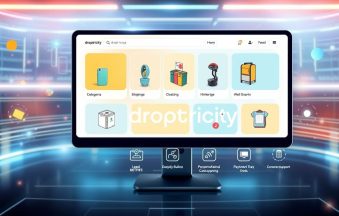Thinking about starting an online business in 2025? Dropshipping might be exactly what you’re looking for. It allows you to sell products without the need to hold any inventory. When a customer places an order with you, your supplier ships the product directly to them. This guide will walk you through the dropshipping process, from selecting products to acquiring your first customers.
Key Takeaways
Dropshipping lets you start a business with very little money upfront, which is pretty cool.
You don’t have to deal with storing products, which saves you a lot of hassle and space.
Finding the right products to sell and good suppliers is really important for how to dropship.
Setting up a simple, good-looking online store helps bring in customers.
Marketing your store through social media and search engines is key to getting sales when you know how to dropship.
Table of Contents
Explaining the Dropshipping Business Model
How Does Dropshipping Work?
A retail fulfillment method in which an online store does not maintain inventory of the products it sells is known as dropshipping. In this model, the store lists products from third-party suppliers and, upon receiving an order, instructs the supplier to ship the product directly to the customer. The seller never physically handles the product. This process is relatively straightforward once you are familiar with it. You set up an online store, list products from suppliers, and when a customer makes a purchase, you notify the supplier to ship the item. The cost you incur is deducted from the price you charge the customer, which determines your profit margin. This approach is one of the most popular ways to launch an online store without significant upfront investment or the need for a large warehouse. By utilizing a system like this, you can eliminate the challenges of managing inventory and shipping logistics.
It is a business model that allows you to focus on marketing and sales while another party manages the tedious tasks of inventory management, logistics, and more. For many new entrepreneurs, this approach is a relief, as they may lack the financial resources or the space to store their products.
Major Benefits of Dropshipping
There are numerous factors that attract individuals to the dropshipping business model. For starters, the initial investment costs are remarkably low. You do not need to purchase inventory, which eliminates the need for a substantial upfront capital investment in products that may not sell. Consequently, this also reduces the associated risks; if a product underperforms, you can simply stop listing it. Additionally, dropshipping offers flexibility in another significant way: you can conduct your business from anywhere with internet access.
Whether you choose to work from a coffee shop or while on vacation, you can tailor your work environment to suit your preferences. Furthermore, you can grow your business at a comfortable pace. Your supplier will handle any increase in order volume if sales suddenly surge, allowing you to focus on other aspects of your business. Since you do not need to maintain any physical stock, you can offer a wide variety of products in your store. Reason: Improved vocabulary, clarity, and overall readability.
Low Startup Costs: No need to invest in bulk inventory.
Flexibility: Operate your business from anywhere with an internet connection.
Wide Product Selection: Offer a diverse catalog without managing stock.
Scalability: Easily grow your business without worrying about warehouse space.
Reduced Risk: Less financial risk since you only pay for products after a sale.
Dangers of How to Dropshipping as It Is
So far, there has been no sunshine or rain. The challenges associated with dropshipping are indeed unique. Suppliers, who are often the largest players in the process, can be a nightmare to deal with. If they miss an order or if shipping takes longer than expected, it can severely damage your reputation, even though your business is not at fault. Additionally, you cannot assess the quality of the products yourself, which means you are entirely reliant on the supplier to deliver satisfactory items.
Customer service also suffers; you must constantly follow up on delayed orders and manage returns, all of which are beyond your control. Moreover, it is easy to fall behind in this competitive landscape, making the competition incredibly fierce. You must put in significant effort to stand out. Furthermore, the profit margins in dropshipping are typically thinner than those in traditional retail, so you need to sell a substantial volume to earn a decent income.
Supplier Reliability: Issues with shipping or product quality can impact your reputation.
Customer Service: Handling returns and inquiries can be complex without direct control over inventory.
Competition: The low barrier to entry means many other businesses are doing the same thing.
Thin Profit Margins: You might need to sell a high volume to achieve significant profits.
Inventory Management: Keeping track of supplier stock levels can be difficult.

Strategic Niche Selection For How to Dropshipping You
Select the Right Niche. This is arguably one of the most crucial factors in establishing your dropshipping store. It is akin to choosing your battlefield; you want to select a market where you have a significant chance of success, rather than getting lost in a sea of competition. By opting for a specific niche, you can create a well-defined product mix with reduced competition and more targeted marketing, ultimately saving you substantial amounts of money in the long run.
Determine the Profitable Product Subcategories
The first step in identifying a product that will yield genuine profit is to explore various product categories. You certainly don’t want to sell something that lacks demand, right? Look for opportunities and products that cater to specific interests. Focus on items that are consistently purchased by the public or emerging trends. Sometimes, a niche may be small, but if the individuals within it are highly passionate, you can achieve significant success. The key is to find a niche with enough room for growth while avoiding oversaturation.
Consider these points when looking for profitable categories:
Products with consistent demand, not just fads.
Items that are hard to find locally make online shopping more appealing.
Products with a good profit margin, so you make money after all your costs.
Things that encourage repeat purchases or have complementary accessories.
Inspect the Market and Observe Consumer Behavior
Following up with a couple of concepts, the next wheelhouse is figuring out if consumers will pay for these products. Keep your eye on the market and your customers, so you know the ropes. Things like Google Trends can show if demand for a product is trending up or down. You need to find a way to play off that trend while you still can before it goes mainstream and gets oversaturated. Listen to conversations on social and online communities, because this is usually where new pains are first articulated.
Let alone what’s hot right now and more likely to stay hot or continue trending. Tomorrow, what is trending today might be obsolete. For the long term and which product kinds will be around forever. This is how you create a business that lasts.
Investigating the Strategies of Competitors
Last but not least, to see what your competitors are doing. And what else is sold in your selected niche? What do they begin with? How are they marketing these products? What you are not doing is trying to completely replicate them; you can learn a lot from their successes and failures. Check their product pages, the social media ads they use, and the reviews by customers. You can tell what works and what does not, and where you may be able to do something better or, at least, differently.
See Their Product Pages, Ad Out Social Media, and Customer Reviews
When checking out competitors, ask yourself:
What are their strengths and weaknesses?
Are there gaps in their product offerings that you can fill?
How do they handle customer service and shipping?
What kind of marketing messages do they use that seem to work?
Sourcing Reliable Suppliers for How to Dropship
Finding the right suppliers is probably one of the most important things you’ll do when you start dropshipping. Think about it: these folks are holding your business in their hands. They’re the ones who send the stuff to your customers, so if they mess up, it reflects badly on you. You need partners you can count on, people who are going to deliver good products on time, every time. It’s not just about getting the cheapest price; it’s about building a solid foundation for your business.
Finding Quality Dropshipping Partners
When you’re looking for suppliers, you’ve got a few options. There are big directories out there, and then there are specific platforms designed just for dropshippers. You want to find partners who have a good track record. Don’t just pick the first one you see. Look at their reviews, see what other sellers are saying about them. Are they known for shipping things quickly? Do they have good customer service if something goes wrong? A reliable supplier is the backbone of a successful dropshipping business. You might even want to order a sample product from them yourself, just to check out the quality and see how long shipping takes. It’s worth the small investment to avoid big headaches later. Some popular options for finding suppliers include dropshipping suppliers like Shopify Collective and other specialized platforms.
Evaluating Supplier Reliability and Shipping
Once you’ve got a few potential suppliers in mind, it’s time to really dig into their reliability. This isn’t just about whether they send the product; it’s about the whole process. How fast do they process orders? What are their typical shipping times to your target market? Are they transparent about their inventory levels? You don’t want to sell something only to find out it’s out of stock. Also, consider their return policy. If a customer needs to send something back, how does that work? You need a clear process that doesn’t leave you or your customer in the lurch. Communication is key here. A good supplier will be responsive and clear about their operations.
It’s easy to get caught up in finding the lowest price, but remember that a slightly higher cost for a truly reliable supplier can save you a lot of money and stress in the long run. Customer satisfaction is directly tied to how well your suppliers perform.
Building Strong Supplier Relationships
This might sound a bit formal, but building a good relationship with your suppliers is super important. It’s not just a one-off transaction. You’re going to be working with these people regularly. Being polite, clear in your communication, and paying on time can go a long way. If you have a good relationship, they might be more willing to help you out if there’s a problem, or even give you a heads-up about new products or special deals. Think of them as an extension of your team. Regular check-ins, even just a quick email, can help keep things smooth. It’s all about mutual respect and making sure both sides benefit from the partnership.
Building Your Online Store for How to Dropshipping
Once you have your products and suppliers sorted, the next big step is setting up your online storefront. This is where customers will see your products and make purchases. Think of it as your digital shop window and checkout counter all rolled into one. Getting this right is pretty important because it directly impacts how people feel about your brand and whether they decide to buy from you.
Choosing the Right E-commerce Platform
Picking the right platform for your online store is a big decision. There are a bunch of options out there, each with its own set of features, pricing structures, and ease of use. You want something that fits your budget, is easy to manage, and can grow with your business. Some platforms are super simple for beginners, while others offer more advanced customization for experienced users. It’s important to pick a platform that makes managing your products and orders straightforward.
Here are some popular choices:
Shopify: Known for its user-friendly interface and extensive app store.
WooCommerce: A flexible, open-source option for WordPress users.
BigCommerce: Offers robust features for scaling businesses.
Wix: Great for beginners with drag-and-drop design tools.
Consider what kind of technical skills you have. If you’re not super tech-savvy, a platform with a lot of built-in tools and customer support might be a better fit. If you like to tinker and have more control, an open-source option could be more appealing. The goal is to make the process of setting up and running your store as smooth as possible.
Designing an Engaging User Experience
Your store’s design isn’t just about looking pretty; it’s about making it easy and enjoyable for customers to shop. A good user experience (UX) means clear navigation, fast loading times, and a logical flow from browsing to checkout. People get frustrated quickly if they can’t find what they’re looking for or if the site is slow. First impressions count here.
Think about these elements:
Clear Product Pages: High-quality images, detailed descriptions, and customer reviews.
Intuitive Navigation: Easy-to-find categories, search bar, and filters.
Simple Checkout Process: Minimize steps and offer various payment options.
Consistent Branding: Use your logo, colors, and fonts throughout the site.
Optimizing for Mobile Responsiveness
More and more people are shopping on their phones these days. If your store doesn’t look good and function well on a mobile device, you’re going to lose out on a lot of potential sales. Mobile responsiveness means your website automatically adjusts its layout and content to fit different screen sizes, whether it’s a smartphone, tablet, or desktop computer. This isn’t just a nice-to-have; it’s a must-have.
To check if your site is mobile-friendly, you can:
Test it on your own phone and tablet.
Use Google’s Mobile-Friendly Test tool.
Ensure all buttons and text are easily clickable and readable on smaller screens.
Making sure your online store is well-built and user-friendly is a big part of your dropshipping success. For a deeper dive into choosing the right platform, check out this guide on e-commerce platforms.
Effective Marketing Strategies for How to Dropship

Marketing is how people find your store and products. Without good marketing, even the best products won’t sell. It’s about getting the word out and making sure the right people see what you offer. A solid marketing plan is key to making sales and growing your dropshipping business. You need to think about where your potential customers spend their time online and how you can reach them effectively.
Leveraging Search Engine Optimization
Search Engine Optimization, or SEO, is about making your store show up higher in search results when people look for products you sell. It’s a long-term strategy, but it pays off by bringing in free, organic traffic. Think about what words people would type into Google to find your products. Those are your keywords. You want to use those keywords naturally in your product descriptions, blog posts, and even your website’s page titles.
Keyword Research: Find out what terms your target audience uses. Tools can help you see how many people search for certain phrases and how competitive those phrases are.
On-Page SEO: Optimize your product pages and blog content. This means using your keywords in headings, descriptions, and image alt text. Make sure your content is helpful and easy to read.
Technical SEO: Ensure your website loads fast, is mobile-friendly, and has a clear structure. Search engines like sites that are easy to navigate and perform well.
Backlinks: Get other reputable websites to link to your store. This tells search engines that your site is trustworthy and authoritative.
Focusing on SEO from the start can build a strong foundation for your business. It’s not about quick wins, but about steady, sustainable growth that brings in customers who are actively looking for what you sell.
Implementing Social Media Marketing
Social media is a powerful tool for dropshippers because it’s visual and allows for direct interaction with potential customers. Platforms like Instagram, TikTok, and Facebook are great for showcasing products and building a community around your brand. It’s not just about posting pictures; it’s about creating engaging content that makes people want to learn more.
Content Creation: Post high-quality images and videos of your products. Show them in use, highlight their benefits, and create lifestyle content that resonates with your audience.
Platform Selection: Choose the social media platforms where your target audience spends the most time. Don’t try to be everywhere at once; focus your efforts where they’ll have the most impact.
Engagement: Respond to comments and messages, run polls, and ask questions to encourage interaction. Building a relationship with your followers can turn them into loyal customers.
Paid Social Ads: Consider running targeted ads on social media. These allow you to reach specific demographics, interests, and behaviors, putting your products in front of people most likely to buy.
Utilizing Email Marketing Campaigns
Email marketing is one of the most effective ways to build customer loyalty and drive repeat sales. Once you get someone’s email address, you have a direct line of communication with them. It’s a personal way to share updates, promotions, and new product arrivals.
List Building: Offer incentives like discounts or free guides to encourage website visitors to sign up for your email list. Pop-ups and dedicated sign-up forms are common ways to do this.
Welcome Series: Set up an automated series of emails for new subscribers. This can introduce your brand, highlight popular products, and offer a special discount for their first purchase.
Promotional Emails: Send emails about sales, new product launches, or holiday promotions. Make sure these emails are visually appealing and have a clear call to action.
Abandoned Cart Reminders: If a customer adds items to their cart but doesn’t complete the purchase, send them a reminder email. Often, a gentle nudge or a small incentive can bring them back to finish their order.
Customer Retention: Send personalized emails based on past purchases or browsing history. This can include product recommendations or exclusive offers for loyal customers.
Managing Operations and Customer Service in How to Dropshipping

Streamlining Order Fulfillment Processes
Once your store is up and running, getting orders out the door smoothly is key. It’s not just about making sales; it’s about making sure customers get what they paid for, and quickly. Automating as much of your order processing as possible is a game-changer. This means using tools that talk to your suppliers directly when an order comes in. Think about it: instead of you manually sending an email or filling out a form for every single sale, the system does it for you. This cuts down on mistakes and speeds things up a lot. You’ll want to keep an eye on your order tracking, too. Make sure you’re getting updates from your suppliers so you can pass that info along to your customers. A good system will also help you manage different suppliers if you’re sourcing products from various places. It’s all about making the journey from “click to buy” to “package delivered” as painless as possible.
Providing Exceptional Customer Support
Even with the best products and the smoothest operations, questions and issues will pop up. How you handle them makes all the difference. Think of yourself as the main point of contact for your customers, even though you don’t physically handle the products. Being quick to respond is super important. No one likes waiting days for an answer. Set up clear ways for customers to reach you, like an email address, a contact form, or even a live chat feature. When they do reach out, be friendly, understanding, and try to solve their problem on the first try. Sometimes, it’s just about giving them accurate information about their order status. Other times, it might be a product question. The goal is to make them feel heard and valued. Remember, happy customers are more likely to come back and tell their friends. For tips on how to improve customer interactions, check out these customer service strategies.
Handling Returns and Refunds Efficiently
Returns are just part of doing business, especially in e-commerce. While no one loves them, how you manage them can build trust with your customers. Have a clear, easy-to-understand return policy posted on your website. This way, customers know what to expect before they even buy something. When a return request comes in, act fast. You’ll need to coordinate with your supplier to see how they handle returns and refunds. Sometimes, they’ll want the item sent back to them; other times, they might just issue a refund without needing the product back. Your job is to be the go-between, making sure the customer gets their money back or a replacement product without a lot of hassle. A smooth return process can turn a potentially negative experience into a positive one, showing customers you stand behind your products and care about their satisfaction.
Managing operations and customer service effectively in dropshipping isn’t just about fixing problems; it’s about building a reputation for reliability and care. Every interaction, from order confirmation to handling a return, shapes how customers view your business. Prioritizing these areas can lead to repeat business and positive word-of-mouth, which are invaluable for long-term success.
Financial Planning and Legal Considerations for How to Dropship
Setting Up Business Finances
Getting your money matters in order is a big deal for any business, and dropshipping is no different. Keeping your personal and business money separate is a smart move from day one. It just makes everything cleaner and easier to track. Think about opening a bank account just for your business. This way, when money comes in from sales or goes out for products, it’s all in one spot. A business credit card can also be super helpful for paying for things like ads or software subscriptions. It helps you build a credit history for your business, which can be useful down the road.
It’s easy to mix personal and business funds when you’re just starting out, especially if you’re working from home. But trust me, a little bit of effort now to set up separate accounts will save you a lot of headaches when tax season rolls around. It makes understanding your business’s true financial picture much clearer.
Open a dedicated business bank account: This keeps your income and expenses organized.
Consider a business credit card: Useful for tracking business spending and building credit.
Budget for ongoing costs: Don’t forget platform fees, marketing, and other operational expenses.
Understanding Tax Obligations
Taxes can feel like a maze, but you’ve got to figure them out. What you owe can change a lot depending on where you live and where your customers are. For example, sales tax is a big one. Some states or countries require you to collect sales tax from customers, while others don’t, or only for customers in your state. It’s not always straightforward, so doing your homework on this is key. You might need a sales tax ID or an Employer Identification Number (EIN) if you’re in the US, especially for tax purposes and dealing with suppliers.
Ensuring Legal Compliance and Regulations
Beyond taxes, there are other legal bits to sort out. You might need a business license, even if you’re just working from your kitchen table. These rules vary a lot by city, state, or country, so you’ll need to check with your local government. Also, think about how you’re setting up your business legally. A sole proprietorship is simple, but an LLC (Limited Liability Company) can give you more protection for your assets if something goes wrong with the business. Getting a resale certificate might also be necessary in some places to buy products without paying sales tax yourself. It’s all about making sure you’re playing by the rules.
Legal Structure | Key Feature | Liability Protection | Tax Implications |
|---|---|---|---|
Sole Proprietorship | Easiest to set up, no separation | None | Business income is personal income |
Limited Liability Co. | Separates personal and business assets | High | Can be taxed asa pass-through or a corporation |
Corporation | More complex, separate legal entity | High | Separate corporate tax, potential double tax |

Conclusion
So… pretty much that. Enter dropshipping, and you can begin an online business with not a lot of money required, or a full warehouse full of products. If you select the right products, find the right suppliers, and also build a good-looking website, you can walk. Keep in mind to manage the money and legal stuff better than just launching. Stay alert to how it is going and be able to pivot if need be. Hopefully that helps. Good luck!👍
Frequently Asked Questions
What exactly is dropshipping?
Dropshipping lets you sell things online without keeping products yourself. When a customer buys something from your store, a supplier sends it directly to them. This means you don’t need a big warehouse or a lot of money to start.
How do I start dropshipping as a beginner?
To begin, first pick what kind of products you want to sell. Then, find good suppliers who can send those products. Next, set up an online store, like on Shopify, and then tell people about your store using social media or ads.
Is dropshipping still a good idea in 2025?
Yes, dropshipping can still be a good way to make money in 2025. The online shopping world keeps growing, and dropshipping lets you jump in without a lot of risk. It’s all about finding the right products and reaching the right customers.
How much money do I need to start dropshipping?
You don’t need a lot of money to start dropshipping. You mostly need to pay for your website and some marketing. Since you don’t buy products until someone orders them, you save a lot on storage costs.
How do I choose the right products to sell?
It’s super important to pick products that people want to buy. Look for things that are popular but not sold everywhere. Think about what problems people have and what products could fix them. Also, make sure the products aren’t too big or too fragile to ship easily.
Where can I find reliable suppliers for my dropshipping business?
Finding good suppliers is key. Look for ones with good reviews, fair prices, and fast shipping. You can use platforms like SaleHoo or AliExpress to find them. Always try to talk to a few suppliers before picking one to work with.










Add comment